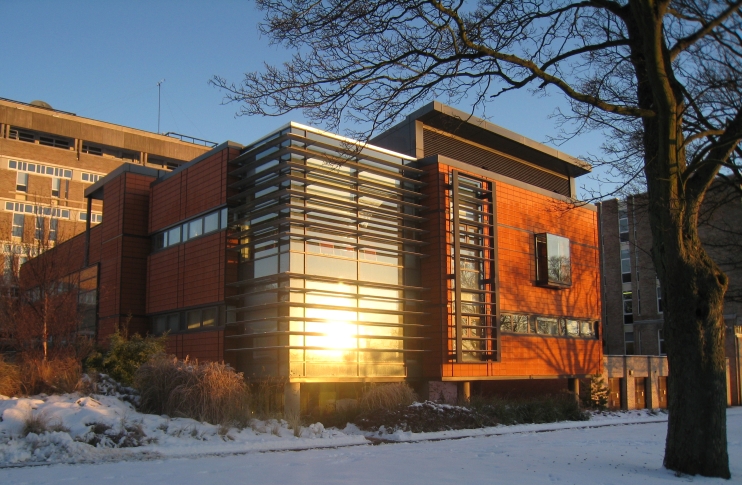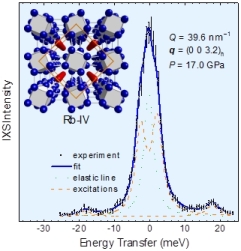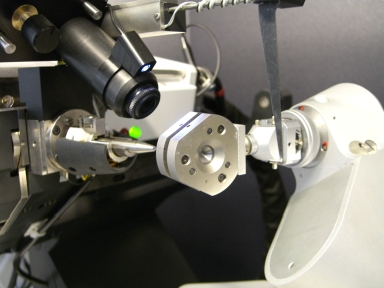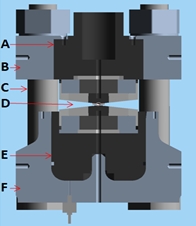CSEC is the Centre for Science at Extreme Conditions at the University of Edinburgh. We are a collaborative research institution that brings together researchers from the Schools of Biological Sciences, Chemistry, Engineering, GeoSciences and Physics & Astronomy, with interests in experiments at high pressures, under magnetic fields and over a wide range of temperatures; in extreme conditions technologies; and in computational materials science.
The mission of CSEC is to  carry out adventurous and far-reaching research through enhanced facilities for sample preparation and characterisation, exploitation of multi-disciplinary expertise in extreme conditions science, and effective use of central facilities for neutron and synchrotron x-ray scattering. We are a vibrant, successful and interactive research centre that generates and exploits new ideas and discoveries in the field of extreme conditions science, and we are internationally recognised as one of the world’s leading extreme conditions science centres.
carry out adventurous and far-reaching research through enhanced facilities for sample preparation and characterisation, exploitation of multi-disciplinary expertise in extreme conditions science, and effective use of central facilities for neutron and synchrotron x-ray scattering. We are a vibrant, successful and interactive research centre that generates and exploits new ideas and discoveries in the field of extreme conditions science, and we are internationally recognised as one of the world’s leading extreme conditions science centres.
Research Activities
 CSEC has a diverse research programme that encompasses major themes of contemporary extreme conditions science. Surprising new structures and properties of Fundamental Systems such as elements and simple molecules continue to be discovered, this is related to Extreme Geosciences studies of Earth and other planetary interiors. Molecular and Biological Sciences describes high pressure investigations of increasingly complex systems, from pharmaceuticals to proteins to bacteria and the possibilities of life on other planets. Synthesis and property measurements at extreme conditions support our Materials Discovery activities, and all of CSEC’s research is enabled by the development of State of the Art Techniques.
CSEC has a diverse research programme that encompasses major themes of contemporary extreme conditions science. Surprising new structures and properties of Fundamental Systems such as elements and simple molecules continue to be discovered, this is related to Extreme Geosciences studies of Earth and other planetary interiors. Molecular and Biological Sciences describes high pressure investigations of increasingly complex systems, from pharmaceuticals to proteins to bacteria and the possibilities of life on other planets. Synthesis and property measurements at extreme conditions support our Materials Discovery activities, and all of CSEC’s research is enabled by the development of State of the Art Techniques.
Further information about CSEC Research
Equipment and Facilities
In order to use the CSEC equipment within the Erskine Williamson Building, you must read the CSEC Safety Information and complete a CSEC Registration Form available by contacting the CSEC Superintendent Katalin.Kis [at] ed.ac.uk.
Shared equipment, such as high  pressure diffraction and spectroscopy facilities and low temperature property measurement platforms, is located in the central Erskine Williamson building. Other specialised equipment is housed in the five participating Schools on the King’s Buildings campus of the University of Edinburgh. CSEC infrastructure for neutron and synchrotron scattering experiments is at the Harwell Oxford National Science and Innovation Campus.
pressure diffraction and spectroscopy facilities and low temperature property measurement platforms, is located in the central Erskine Williamson building. Other specialised equipment is housed in the five participating Schools on the King’s Buildings campus of the University of Edinburgh. CSEC infrastructure for neutron and synchrotron scattering experiments is at the Harwell Oxford National Science and Innovation Campus.
Further information about CSEC Equipment and Facilities
History
 Pioneering work during the 1990’s by University of Edinburgh scientists in high pressure neutron scattering, through the development of the Paris-Edinburgh cell, and in high pressure x-ray diffraction at the Daresbury Synchrotron Radiation Source, laid the foundations for CSEC. The centre was established through an award from the UK Research Councils’ Joint Infrastructure Fund in 2000 to create a world-class facility for extreme conditions science and engineering. Further important support came from the Leverhulme Trust through a major award that created several new staff positions.
Pioneering work during the 1990’s by University of Edinburgh scientists in high pressure neutron scattering, through the development of the Paris-Edinburgh cell, and in high pressure x-ray diffraction at the Daresbury Synchrotron Radiation Source, laid the foundations for CSEC. The centre was established through an award from the UK Research Councils’ Joint Infrastructure Fund in 2000 to create a world-class facility for extreme conditions science and engineering. Further important support came from the Leverhulme Trust through a major award that created several new staff positions.
The Erskine Williamson Building of CSEC was designed by The Hurdrolland Partnership and constructed between 2001 and 2003. It is named in honour of Erskine Douglas Williamson - an Edinburgh-born graduate of the University who became an outstanding pioneer of extreme conditions research at the Carnegie Institution of Washington in the early part of the 20th century. His legacy includes the Adams-Williamson equation, which made it possible to deduce the interior structure of the Earth from seismic velocity measurements. CSEC was opened by Lord Sainsbury, Under-Secretary of State for Science and Innovation, on 30th April 2004, and has since grown into an organisation of around 75 researchers.
For further information and photographs from the construction of the Erskine Williamson Building see The CSEC Chronicle.